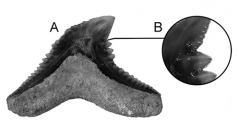

 European Journal of Taxonomy
2019 (585) - Pages 1-274
European Journal of Taxonomy
2019 (585) - Pages 1-274The Tallahatta Formation, Lisbon Formation, and Gosport Sand are the three lithostratigraphic units that make up the lower-to-middle Eocene Claiborne Group. In Alabama, these marine units are among the most fossiliferous in the state and a long history of scattered reports have attempted to document their fossil diversity. In this study, we examined 20 931 elasmobranch and bony fish elements, including otoliths, derived from Claiborne Group units in Alabama and identified 115 unequivocal taxa. Among the taxa identified, one new species is described, Carcharhinus mancinae sp. nov., and Pseudabdounia gen. nov. is a new genus erected to include two species formerly placed within Abdounia Capatta, 1980. New taxonomic combinations proposed include Pseudabdounia claibornensis (White, 1956) gen. et comb. nov., Pseudabdounia recticona (Winkler, 1874) gen. et comb. nov., Physogaleus alabamensis (Leriche, 1942) comb. nov., and Eutrichiurides plicidens (Arambourg, 1952) comb. nov. We also report the first North American paleobiogeographic occurrences of Aturobatis aff. A. aquensis Adnet, 2006, Brachycarcharias atlasi (Arambourg, 1952), Eutrichiurides plicidens comb. nov., Galeorhinus louisi Adnet & Cappetta, 2008, Ginglymostoma maroccanum Noubhani & Cappetta, 1997, Gymnosarda sp., Mennerotodus sp., Rhizoprionodon ganntourensis (Arambourg, 1952), Stenoscyllium aff. S. priemi Noubhani & Cappetta, 1997, Trichiurus oshosunensis White, 1926, and the first North American occurrence for a fossil member of the Balistidae Risso, 1810. Our sample also included 26 taxa that represented first paleobiogeographic occurrences for Alabama, including Abdounia beaugei (Arambourg, 1935), Albula eppsi White, 1931, Ariosoma nonsector Nolf & Stringer, 2003, Anisotremus? sp., Anomotodon sp., Brachycarcharias twiggsensis (Case, 1981), Burnhamia daviesi (Woodward, 1889), Eoplinthicus yazooensis Capetta & Stringer, 2002, Galeorhinus ypresiensis (Casier, 1946), Gnathophis meridies (Frizzell & Lamber, 1962), Haemulon? obliquus (Müller, 1999), Hypolophodon sylvestris (White, 1931), Malacanthus? sulcatus (Koken, 1888), Meridiania cf. M. convexa Case, 1994, Palaeocybium proosti (Storms, 1897), Paraconger sector (Koken, 1888), Paralbula aff. P. marylandica Blake, 1940, Phyllodus toliapicus Agassiz, 1844, Propristis schweinfurthi Dames, 1883, Pycnodus sp., Pythonichthys colei (Müller, 1999), Scomberomorus stormsi (Leriche, 1905), Signata stenzeli Frizzell & Dante, 1965, and Signata nicoli Frizzell & Dante, 1965, and the first Paleogene occurrences in Alabama of a member of the Gobiidae Cuvier, 1816. A biostratigraphic analysis of our sample showed stratigraphic range extensions for several taxa, including the first Bartonian occurrences of Eoplinthicus yazooensis, Jacquhermania duponti (Winkler, 1876), Meridiania cf. M. convexa, Phyllodus toliapicus, and “Rhinobatos” bruxelliensis (Jaekel, 1894), range extensions into the late Ypresian and Bartonian for Tethylamna dunni Cappetta & Case, 2016 and Scoliodon conecuhensis Cappetta & Case, 2016, the first late Ypresian records of Galeorhinus louisi, the first Lutetian occurrence of Gymnosarda Gill, 1862, and a range extension for Fisherichthys aff. F. folmeri Weems, 1999 into the middle Bartonian. Larger biostratigraphic and evolutionary trends are also documented, such as the acquisition of serrations in Otodus spp., possible population increases for the Rhinopterinae Jordan & Evermann, 1896 and Carcharhiniformes Compagno, 1973 in the Bartonian, and the apparent diversification of the Tetraodontiformes Berg, 1940 during the same stage. This study helps better our understanding of early-to-middle Eocene elasmobranch and bony fish diversity, paleobiogeography, and biostratigraphy in the Gulf Coastal Plain of North America.
Tallahatta Formation, Lisbon Formation, Gosport Sand, Gulf Coastal Plain, Elasmobranchii, Teleostei